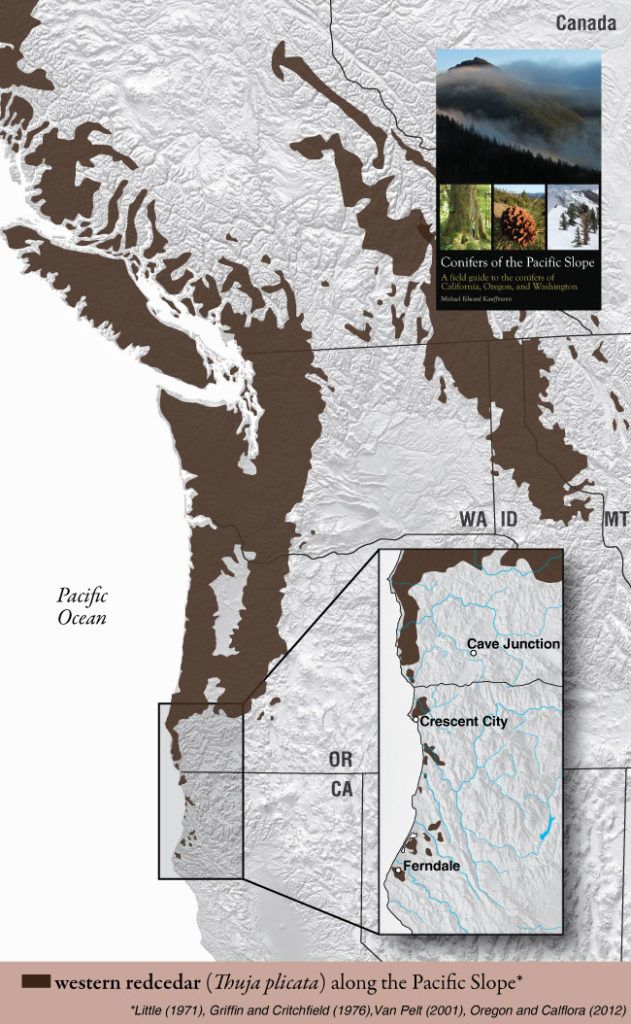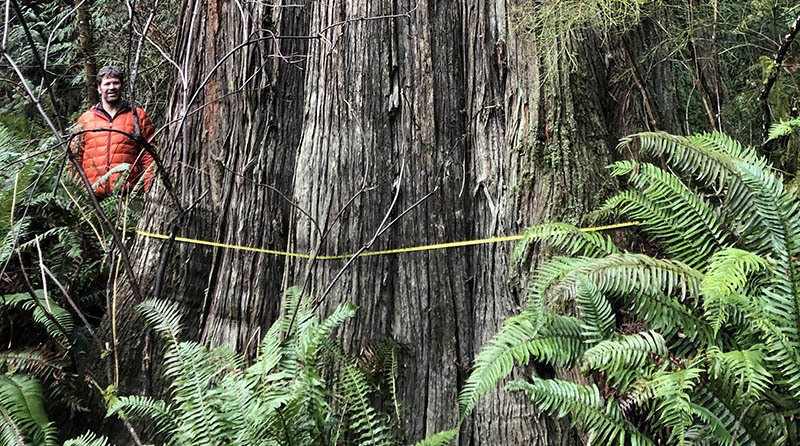From Alaska south to Oregon western redcedar (Thuja plicata) is the signature tree of the Pacific Northwest temperate rainforest. It has mythic importance to native people, as entire civilizations were sustained, in large part, by this species. Natives of the Pacific Northwest regarded the species as a “Long Life Maker” (Stewart 1984) because they used it for canoes, paddles, houses, roofs, clothes, bedding, rope, cooking, and even medicine. Few giant trees were actually felled before the arrival of Europeans because old snags were usable for many years after death. Highly resistant to rot, the snags or parts of live trees would be harvested instead of the entire live tree. After building a dugout canoe from a tree, Lewis and Clark named it “arbor vitae,” Latin for “tree of life” (Arno 2007).

Western redcedar is problematic to see in California, particularly old-growth specimens, because it has probably never been regionally common in the Holocene. This species reaches the southern extension of its North American range just south of the Eel River Valley. The other signature trees of the Pacific Northwest—Sitka spruce and western hemlock—grow in a few scattered populations south of Humboldt County. While western redcedar does not, all three reach their southern range extension in relative proximity. Due to the disjunct nature of its California distribution, there are few places to see western redcedar in the region. Predictable habitat includes wet streamsides or cool, damp, north-facing hillsides. It also survives in coastal yards of Humboldt and Del Norte counties, though only for a short time—these landscaping trees rarely get very big or old.
Measuring California’s Largest Western Redcedar
The California Registry of Big Trees did not have a record for this species as of 2019. In December, we changed that. A dedicated crew hiked 6 miles to measure and nominate a new California record! What follows is a photo collage of the trip.






- Arno 2007: Northwest Trees
- Most text adapted from Conifer Country, Kauffmann 2012.
- See the record on the California Registry of Big Trees

Very nice! Thank you for teaching me more about Western red cedar.
You are welcome Brian. It is a cool species. Thanks for visiting the site too.
Michael– That big beautiful trunk is very distinctly fluted. Next time you see it, check to see if each flute leads to a singular root and to a singular limb.
Great idea Ron. My plan is to gradually map and inventory all the big trees. I hope you are well and thanks for all you do for conifers!
Looks like you are up a favorite local watershed. Did you get permission from the city or were you trespassing like the rest of us? Thanks for all your fine work!
Jon- Turns out these trees are on the newly acquired Humboldt State University forest tract. Major grants were secured by the City of Arcata to help with the acquisition. All the players are working to secure better access. I have a “research permit” at this point for mapping the old-growth western redcedar — which will be an ongoing, long-term project.
Wonderful work, Michael! Congratulations! I was wondering if you’ve had a lot of younger Western Red Cedars dying from drought in California. Here in Portland we’ve lost a lot of cedars (around 50-100 years old) in the last three years. I believe the summer of 2018 was the hottest, driest on record for Portland, and it was very hard on the cedars. Best of luck with your cedar mapping and all your good work with trees.
Thanks for sharing your thoughts Christine and sorry to hear about the mortality. It will be interesting to see what this relatively unknown stand of trees has to share in the coming years.
Michael- I admire your work and observations. I recall a rumor of red cedar near Sanger Lake above the Illinois Valley, but all I found were atypical Port Orfords. Genetic investigations indicate limited variation in our California stands…a condition that makes me nervous from an evolutionary standpoint. That said, natural clones exist on our planet and appear to be stable and successful in some species, relying I suppose on normal mutation rates for genetic progress.
Thanks Dean! I checked out those Griffin and Critchfield reports from Sanger Lake about 12 years back when writing Conifer Country. I could definitely see how someone was confused by the atypical Port Orford-cedar there. Thanks for all you do for our conifers.